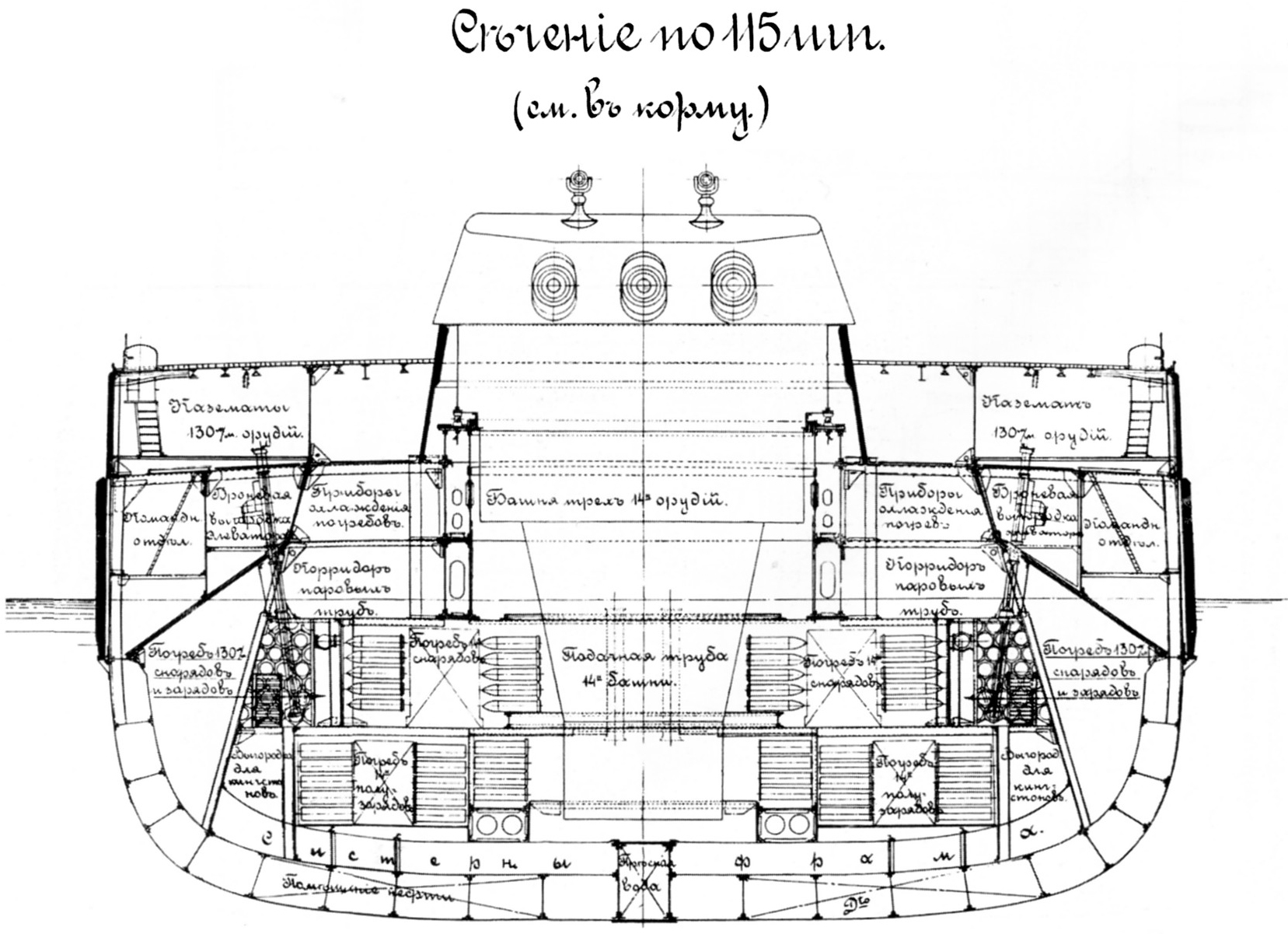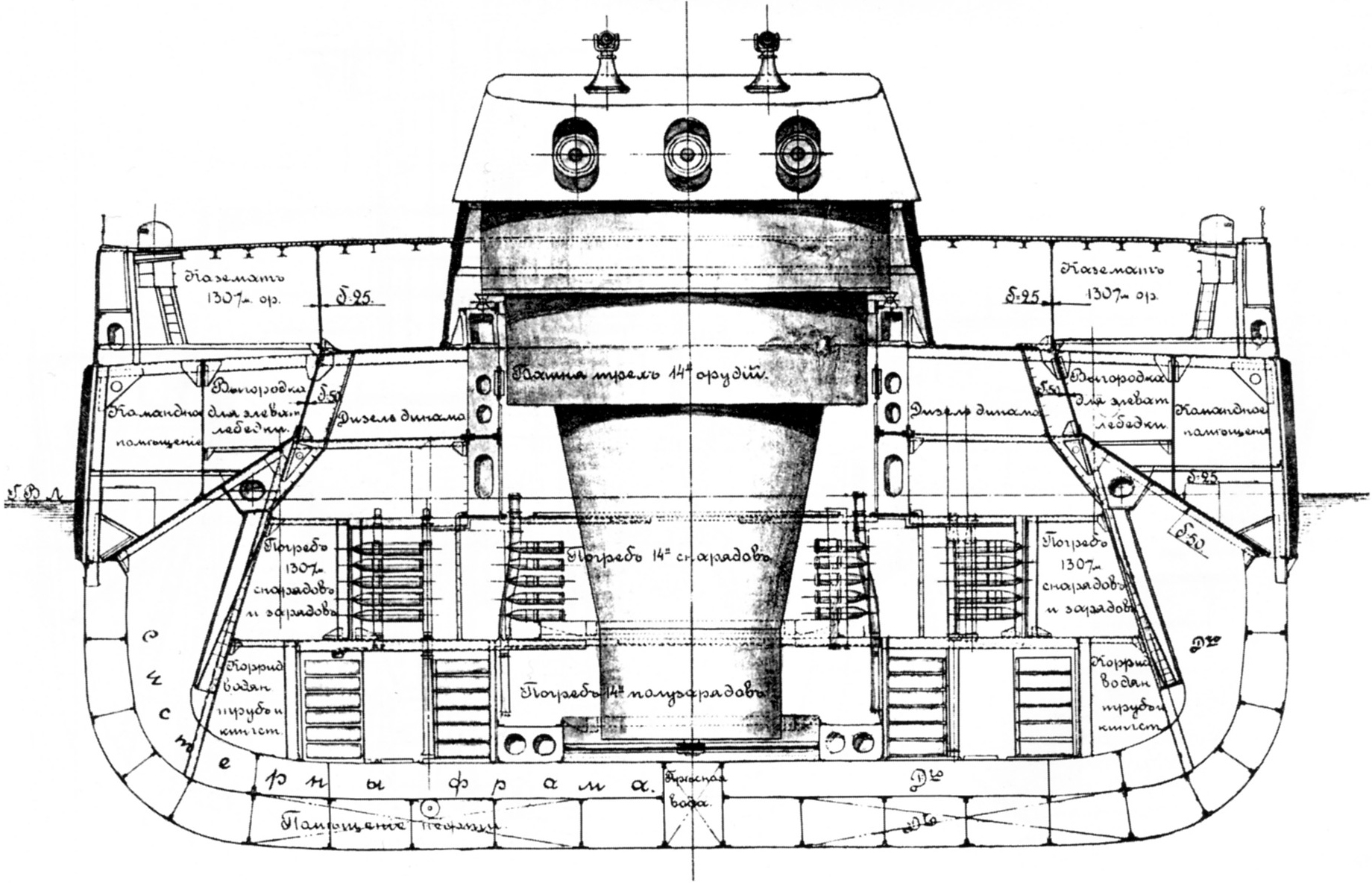- Yes! Izmail (the only one that could’ve been finished)
- yes! Borodino (the namesake)
- yes! Kinburn (British Parsons machinery)
- yes! Navarin (German AG Vulkan machinery)
- Nyet!
- yes! both in the research tree- as they are identical it adds depth to the tech tree
- yes! one as a GE or paid premium- sponsored by Gaijin! (probably)
- yes! one as a Squadron Researchable- two ships for the price of… two! in different ways!
- yes! one as an Event Rare- Call it Operation “NOTHING WENT WRONG!”
- yes! one as the main reward of a Battle Pass Season!- These ships are practically made to be the Crowning Achievement of a Battle Pass
- Nyet to all! / Nyet to this!
- Not Sure / Abstain
alternatively this is also called the Izmail-class as the hull of the second ship laid down; Izmail; was launched first and the only one that ever had a chance of actually being completed in the Soviet era, but is officially called the Borodino-class clearly in honor of the lead ship of the Borodino-class pre-dreadnought battleships, further supported by all the ships being named after major battles like with the original Borodino: the battles of Borodino, Navarino, Kinburn, and the Siege of Izmail.
artistic rendering of Borodino as it would look if completed
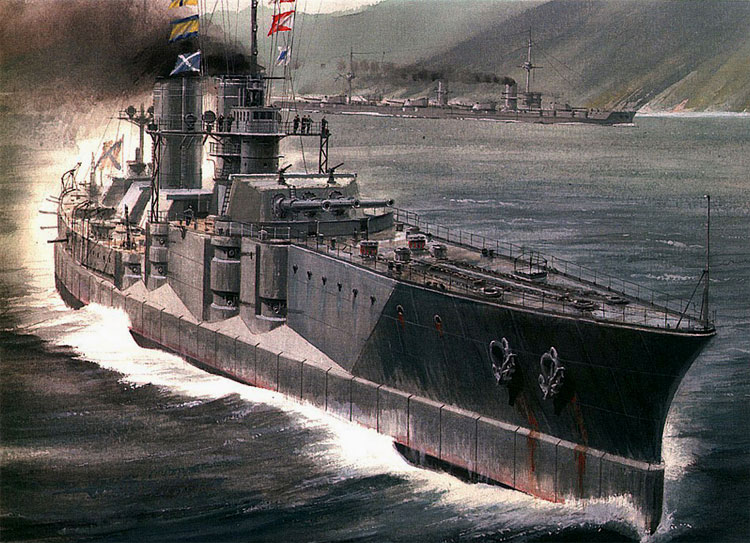
Two views of the Borodino class - unknown what Russian book:
the original intended design in 1911 (top)
how it would’ve been completed in 1916 with mid-construction design revisions (bottom)
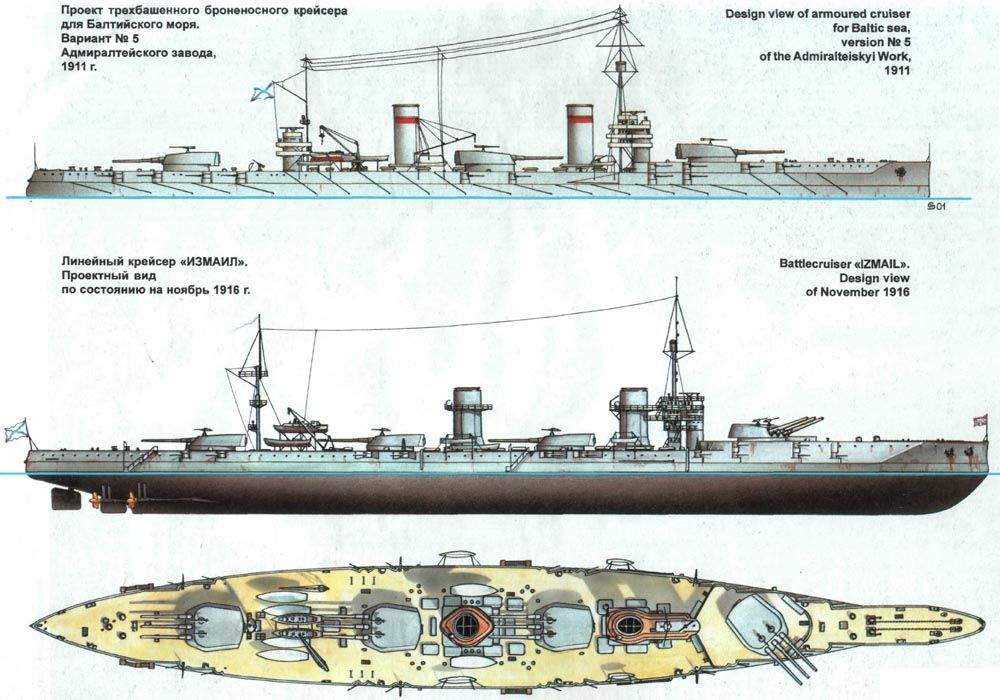
Измаил (Izmail) upon launch at Baltic Works, Petrograd, June 9th, 1915

Бородино (Borodino), wide angle view from Admiralty Shipyards, Petrograd, July 19th, 1915

Кинбурн (Kinburn), the bow from ground level, immediately prior to launching, from Baltic Works, Petrograd, October 30th, 1915

Наварин (Navarin) from a wide angle bow view prior to launching from Admiralty Shipyards, November 9th, 1916

DESIGN WOES:
The origins of the Borodino-class battlecruiser; like just about all ships built in the Russian navy between 1906-1914; lie in the disastrous aftermath of the Russo-Japanese war of 1904-05, where this eventual battlecruiser class would get both its lead ship namesake, and even namesake references.
You see, the aftermath of the Russo-Japanese war was one where half the Imperial Russian Navy and most of its competent admirals were sunk and/or captured between the Battle and eventual loss of Port Arthur, Battle of Yellow Sea, and the Battle of Tsushima, the modern Imperial Russian Navy would have to be rebuilt almost from scratch… Though at least they still had Slava.
And thus begun the Russians chronically unsuccessful love affair with large, fast capital ships that lasted until Khrushchev cancelled them altogether.
Initial calls for designs in the late 1900s were for ships reminiscent of the Japanese Tsukuba and Kurama classes- Armored Cruisers with pre-dreadnought style 2x2 capital ship main armament and very high 28 knot speeds… yeah, the Russians could’ve countered Lord Fisher’s Dreadnought-Armored Cruiser (AKA proto-Battlecruiser) concept by accident with a Pre-Dreadnought-styled Battlecruiser mimicking the semi-unique Battle Line Armored Cruisers from the nation that had just ended their entire greater Far East Expansion goals alongside half their navy a few years prior… there’s a thought.
|
|
Being both aided by the …uhhh… uh… “quality” of Imperial Russian governance… and a chronic lack of cash… and a Duma the REALLY would’ve liked to focus on the more pressing issue of some flavor of radical revolutionary being around every corner, this whole process would drag on to late 1911.
Eventually a 1911 design from Admiralty Shipyard was selected for construction in 1912 under the “Program for the Rapid Strengthening of the Baltic Fleet 1912 - 1916”.
This process would then almost immediately run into issues thanks to the perennial Russian issue of; again, money; and ultimately millions of rubles were cannibalized from a much more successful building program for Svetlana-class light cruisers.
Throughout the next few years, despite being the top priority of both Petrograd shipyards of Admiralty and Baltic Works, construction would have ongoing issues at any given time…
…And that’s all thanks to pretty much every single social, economic, and military issue that a modern nation of the time could be faced with… was; all at the same time; by the Russian Empire in its waning years… uhh… spoiler alert.
|
In short, this whole situation can be summed up with a phrase that similarly works for a majority of Russia’s history: “And Then It Got Worse”…
|
|
wide angle cross section of the Borodino-class Battlecruiser

cross section of Borodino-class (stern view)
cross section of Borodino-class (bow view)
HISTORY (what little there is):
ultimately all 4 ships of the class would be launched in a state of middling completion, with Borodino (57%) and especially Izmail (65%) being much farther along compared to Navarin (52%) and Kinburn (50%) and with much more of their machinery ready.
|
|
As 1917 rolled around, that wonderful aforementioned phenomenon known as Russian History (“And Then it got Worse”) showed up to effectively seal the Borodino-class’s fate.
As the Russian Revolution Part 1 began with the February Revolution, those events grounded most shipyard projects to a near-halt (and of which the Borodinos were still top priority) as Russia descended into pandemonium, though somehow the Provisional Government and Bolshevik revolutionaries somehow both still agreed that Izmail at least was still worth completing.
Things would then get even worse as the October Revolution completely stopped any dockyard construction and all 4 hulls were moved to long-term storage.
|
|
Moving to 1921 and near the end of the Russian Civil War as far as it really mattered who might win, the Bolsheviks considered building the Izmail’s turrets, as 11 of her 12 356mm/52 OSZ Pattern 1913 guns were in storage, but the terrible state of Russian heavy industry after years of civil war, lack of maintenance, exposure, and a general atmosphere of total neglect hamstrung that idea.
Plan B; if it could even be seriously considered a plan; was considered where the two half-finished and near-forgotten hulls of Kinburn and Navarin were considered to have the plan of triple 356mm turrets swapped for dual 410mm (16.1-inch) cannons.
unsurprisingly this went absolutely nowhere for numerous reasons:
Russian industry wasn’t able to make 16-inch guns BEFORE the Russian Revolution when its industry WASN’T dilapidated and in severe need of repair.
they couldn’t buy the artillery either because what few nations even had the standard caliber of 16-inch (406mm) cannons this early into the 1920s, had just a couple years prior been assisting the White Russians and uhhh, were still not exactly happy the Bolsheviks weren’t going to be paying any of the substantial debts of Imperial Russia back… and even if they could magically get a source, the country was flat broke, in the catastrophic early stages of a total national reset, and until the mid-1930s; who knows what happened to the experts who could even effect such refits? they were either White Russians, Red Russians, or Dead Russians.
|
after this, last ditch alternatives were then proposed; including conversion to cargo ships, passenger liners (ice sheets and communism apparently being all the rage in the Roaring '20s), or massive oil barges… but these all failed too as being designed as military battlecruisers; a very one trick pony type of ship hull design; they were too long and too thin to be practical for any of these uses.
|
|
fast-forwarding to late 1923, as the Russian Civil War came to a close, the Bolsheviks became the Soviets, and Borodino, Kinburn, and Navarin became scrap as they were sold to; of all people; a German shipbreaking company.
Izmail however was just far enough along and mechanically outfitted to be considered for completion, then in 1925 for conversion to a carrier ala the American Lexington-class carrier conversions… that probably would’ve turned out more like the French battleship-turned-worlds-worst-carrier-conversion Béarn… lets face it with the state of Soviet industry in the 1920s, this wasn’t going to be like the Lexingtons.
proposal for Izmail as the carrier conversion Aviamatka, if this half-baked idea somehow worked

This conversion was initially actually accepted, but the Red Army understandably was more interested in funding the red army and not the near-defuct navy, and had gained control of a committee on naval needs, and used that to get the conversion cancelled, ending any hope of Izmail, last of the Borodino-class Battlecruisers, and any chance of a Soviet capital ship until the Kronshtadt-class battlecruiser attempt during the early WWII era… that also got shafted.
GENERAL CHARACTERISTICS:
Displacement:
32,500 tons (estimated at normal load)
36,600-38,000 tons (estimates at full loads)
|
Length:
221.9 meters at the waterline
228.6 meters overall
|
Beam:
30.5 meters
|
Draft:
8.81 meters (estimated at normal load)
10.2 meters (estimates at full loads)
|
Freeboard (estimated as designed):
8.89 metres (29 ft 2 in) forward
6.24 metres (20 ft 6 in) amidships quarterdeck
6.49 metres (21 ft 4 in) aft
|
|
Powerplant:
fascinatingly for a class of 4 unfinished capital ships, the Borodino-class’s powerplant issues were nothing like most MASS classes of ships. despite Russia having its own factory; the Franco-Russian Works (today part of the JSC Admiralty Shipyard); that had produced boilers and turbines for the Gangut-class, the requirements were enough that foreign produced machinery for at least some of the ships would still be necessary to expedite the process- this being the early 1910s, turbine engines were still fairly recent.
So Borodino and Izmail would have machinery made by Franco-Russian Works as they themselves improved their manufacturing technology and tooling…
Kinburn would have British-made machinery from Parsons… which presumably was seized by the British once WWI broke out.
…and Navarin would have machinery ordered from AG Vulkan in Germany… which would be seized by the Germans the moment WWI kicked off, both as it was now at war, and at war with Russia.
Since none of the Borodino-class ever were completed anyway, i’m including the original manufacturers, if for nothing more than nitpicky ****s and giggles.
|
|
so with that all said, the engines were:
25 Yarrow boilers of mixed propulsion - the forwards boilers with grouped in 3 compartments with 3 fuel oil-fired boilers in each compartment, while the rearward boilers were grouped into 4 compartments with coal-fired boilers with supplementary fuel oil sprays…
…feeding into 4 Parsons steam turbines, produced locally by Franco-Russian Works (Borodino, Izmail), in the UK by Parsons (Kinburn), and by AG Vulkan in Germany (Navarin)
producing estimates of 66,000-68,000 shaft horsepower under normal operation, and was designed to be capable of overloading to produce 90,000 shp through methods like forced draft (overpressurizing the boilers) and the oil sprays accelerating the burn rate and release of energy from the coal…
…going through 4 shafts…
…producing 26.5 knots (49 km/h, 30.5 mph) under normal optimum conditions- very average speed for a pre-WWI battlecruiser, commonly considered the bottom end minimum speed for a battlecruiser or fast battleship…
…but with running the oil sprayers at full blast and pushing the machinery to its 90,000 shp limits with forced draft, could attain a true maximum speed of 28.5 knots (52.8 km/h; 32.8 mph) (a good BC speed for the era).
|
|
Fuel:
1950 tons of coal and 1575 tons of oil
|
|
Endurance:
3,830 nautical miles at cruising speed of 16 knots, 2280 nautical miles at flank speed of 26.5 knots
|
|
Complement:
various sources range from 1174-1250-1252 crew. considering the class was never finished, and if it had been it would’ve been commissioned right into a badly losing war, it’s a safe bet that 1252 is the most likely official choice.
|
|
Additional Mentions:
The hull was subdivided by 25 transverse watertight bulkheads
the engine room was divided by a longitudinal bulkhead.
The double bottom had a height of 1.275 metres (4 ft 2 in),
and the vitals of the ship were protected by a triple bottom that added an extra 875mm (2 ft 10 in) of depth.
ARMOR:
keep in mind the Russian Empire used their own Line and Archin measurement system instead of US/Imperial (feet and inch) or metric, so exact figures don’t always fit neatly into either system
In preparation for the Borodino-class ships soon to begin construction, armor trials using the obsolete ironclad Chesma fitted with an approximation of the Gangut-class’s armor belt, turret, and superstructure layout, and which would greatly affect the armor layout of the Borodino-class - the Krupp Cemented Armor plates original design was greatly reworked, with the plates being resized to now actually match their frames and also provide more support for their joints… and speaking of which, the joint structure for the plates was greatly changed, from its original design to a mortise and tenon joint to improve the shock distribution qualities of high stress impacts. you can see this difference in the 1911 and 1916 design comparison at the top, with the 1911 design having deployable anti-torpedo nets (the diagonal bars) like most battleships vs the 1916 revision that’s omitted them and smooth sided.
As the design needed to be modified in light of this change to both the dimensions of the armor plates, and the method of mounting the armor itself, this slowed construction by 6 months for the Izmail and Borodino (Navarin and Kinburn were not yet laid down).
visual cue- mortise and tenon joint

Additionally beyond the major changes to the belt design, the deck and turret roof armor proved to be too thin and had to be reinforced,
The Borodinos’ deck armour was reinforced beyond the 1911 plan with extra plates and the thickness of the turret roofs was increased.
To compensate for this additional weight, a planned rear conning tower was removed entirely and the thickness of the main belt was slightly reduced, one of the most noticeable changes from the 1911 plans to the 1916 final revision
|
|
Hull Structure:
interestingly the majority of the Borodino-class had hulls made mostly using High Tensile steel, with mild steel only used for the structure of areas that didn’t contribute to the structural integrity of the ship, so the ships are quite literally (if thinly) armored all the way through.
aside from the ship getting swol from its hull alone, armor used is mostly Krupp Cemented Armor (KCA), and occasionally Krupp Non-Cemented Armor (KNC) or even Nickel Steel.
|
|
Armored Belt:
the thickest section was 237.5mm, across 151.2 meters of the middle of the ship (covering the major machinery spaces) with a height of ~5 meters, 3.375 that are above the waterline, 1.64 below.
the remaining fore and aft span along this belt section dropped to 125mm.
|
|
Upper Deck:
upper deck was 37.4mm thick, and the middle deck 40mm of KNC armor layered on top of 25mm of nickel steel as backing over the armor profile of the citadel
|
|
Upper Belt, Forecastle, and Casemates:
the upper belt section above the main waterline belt was 100mm, with a standalone 100mm upper extension between the superfiring casemate guns thinning to 75mm from just forward of the casemates all the way to the bow.
the 100mm part of upper belt would extend over the rear section of the forecastle deck by just a little bit to form a noticeable lip over the deck
the forward casemate guns themselves had 100mm transverse bulkheads
|
|
Citadel Ends and Innards:
behind all the belt armor was a longitudinal splinter bulkhead 25mm thick between the middle and upper decks and 50mm thick between the middle and lower decks.
at the point where the lower deck met the lower edge of the armor belt, there was a composite material slope made for whatever bizarre reason from 50mm of KNC plate over a similarly sloped 25mm plate of nickel steel.
at the forward end of the citadel was a 75mm transverse bulkhead unconnected to the above part.
and the rear of the citadel was protected between the middle and lower decks by a 300mm bulkhead, thinning to 75mm at the same heights as the main belt
|
|
Main Gun Turrets:
aside from the armor revisions such as the turret roofs, these turrets are actually almost unchanged from those seen on the previous Russian capital ship class, the Imperatritsa Mariya-class- and there’s a good reason, as the Imperatritsa Mariya’s were originally meant to be the Superdreadnought successors to the Gangut-class Dreadnought, fitted with literally the same 14-inch guns that would be re-requisitioned from Obukhov specifically for the Borodino-class battlecruiser Izmail; once Obukhov had the means and expertise to actually produce them locally, rather than rely entirely on Vickers in England.
main gun turrets had 300mm sides, and a 150mm roof.
additionally, the turrets gun ports themselves were armored from the inside in exactly the same style as seen ingame on Imperatritsa Mariya, (see below) and were 50mm RHA steel plates.
inside the turrets there was a 25mm bulkhead between each gun, providing minor intra-turret protection in event of turret penetration or and exploding breech.
|
|
Barbettes:
cross section of Borodino-class (bow view), note the shape of the barbette
the upper section of the barbettes above the weather deck were 247.5mm, as well as that middle span section just below the weather deck, and the lower span where they were behind the upper belt, thinned to 147.5mm. As seen above, the barbettes had a conical shape that lessened their effective protective ability, but better protected against shells that plunged through the deck into the belowdeck section of the barbette.
|
|
Conning Tower and Funnel:
the conning tower had 400mm of armor all around abovedeck, and reduced to 300mm below the upper deck.
additionally the funnel uptakes had 50m of armor protection.
|
|
Underwater Protection:
there was a 10mm watertight bulkhead behind the upward extension of the double bottom (the Borodinos had a triple bottom overall), and this became thinner as the hull narrowed fore and aft…
ARMAMENT:
now we get to the star of the show, Russia’s semi-aborted entry into the Superdreadnought generation of gun caliber. much like the situation with the powerplants, for being a gun that was never actually used aboard a warship, there are as many names for this thing as there are shells.
http://www.navweaps.com/Weapons/WNRussian_14-52_mk6.php
The Obukhovski Steel Plant (OSZ), 356mm, 52-caliber, Pattern 1913
Also produced in the UK by Vickers, being initially called the 14-inch Mark B, and once the UK seized the 3 Vickers-produced complete guns, the 14-inch/50 Mark VI.
experimental mounting of a OSZ Pattern 1913 gun produced by Obukhov at a naval test range
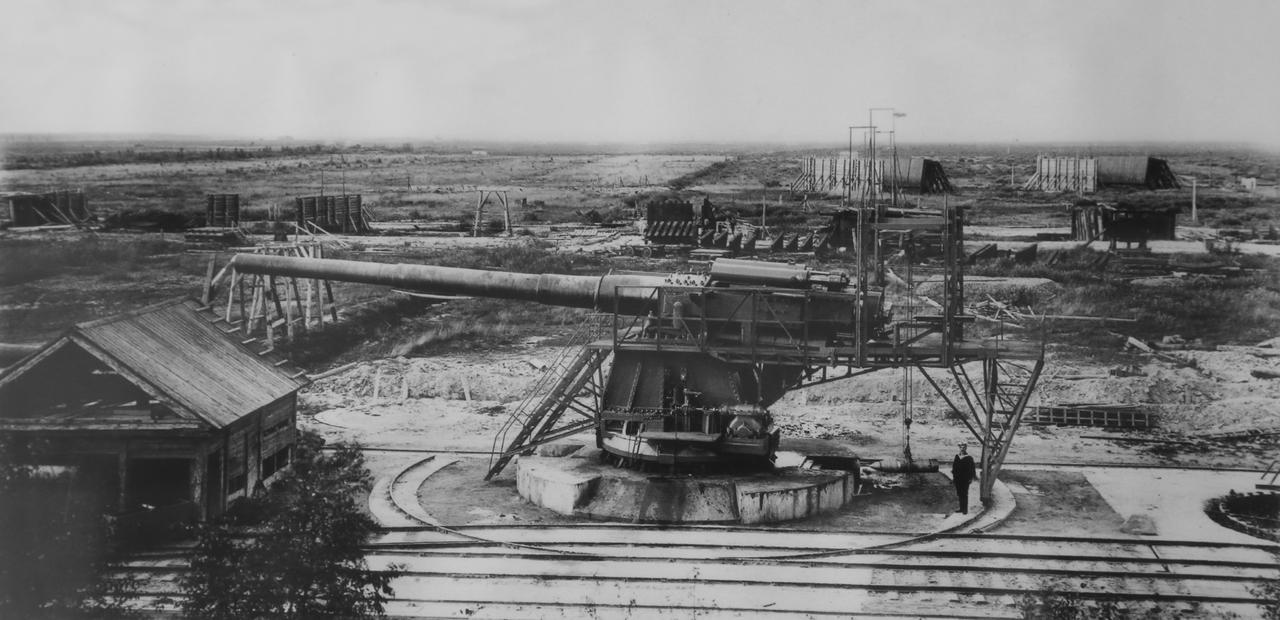
4x3 (14-inch) OSZ 356mm/52 Pattern 1913 cannons - mounted in triple gun turrets extremely similar to those on the Imperatritsa Mariya-class, which was originally supposed to have the exact 14-inch Pattern 1913 guns later re-requisitioned for the Borodino-class.
barrel life was estimated to be ~150 rounds, which was somewhat poor compared to the American 14-inch/45 family (the original 14-inch guns) that had barrel lives of roughly 175-200 full power shells prior to being chrome-lined during WWII.
magazines held 240 shells- 80 shells per gun
additionally alongside the poor estimated barrel life, when the British seized and adopted some of these as the 14-inch Mark VI. Their own testing found these guns to be… structurally subpar… with clear signs of unacceptable levels of internal bulging and longitudinal fragility- AKA fire enough times without rigorous maintenance and the breech may just completely detonate in your face, or the barrel be peeled open like a banana.
cross section on the 52-caliber long barrel

while they never saw service on the high seas… or the frozen shores of the Baltic… after the Borodino-class was entirely abandoned, the 356mm guns would be recycled for use in coastal defense twin-gun turrets, and uniquely, another six was by some miracle successfully mounted on trains; renamed as the TM-1-14 rail gun, fired lower pressure and velocity army shells- and get this: ACTUALLY SAW WARTIME SERVICE, being used in the increasingly desperate defense of Leningrad during the Siege of Leningrad, at least according to the Russian wiki: “During the siege of Leningrad, they successfully fired at the Nazis’ manpower, equipment and defensive structures”
so yeah, early superdreadnought-era 14-inch guns that never went to sea wound up being an bizarre and ironic miniature reverse Schwerer Gustav.
in the Borodinos intended triple turret mount: elevation was -5 to +25 degrees, min/max loading angles of -5 to +15 degrees, a blistering fast 2.5-3 RPM rate of fire (24-20 second reload, that is HALF that of the american 14-inch guns) depending on source, and 3 degree per second horizontal and vertical traverse.
cross section of the entire turret, barbette, ammo magazine, and machinery; featuring turret elevation and depression angles (apparently a copy of the original drawing)
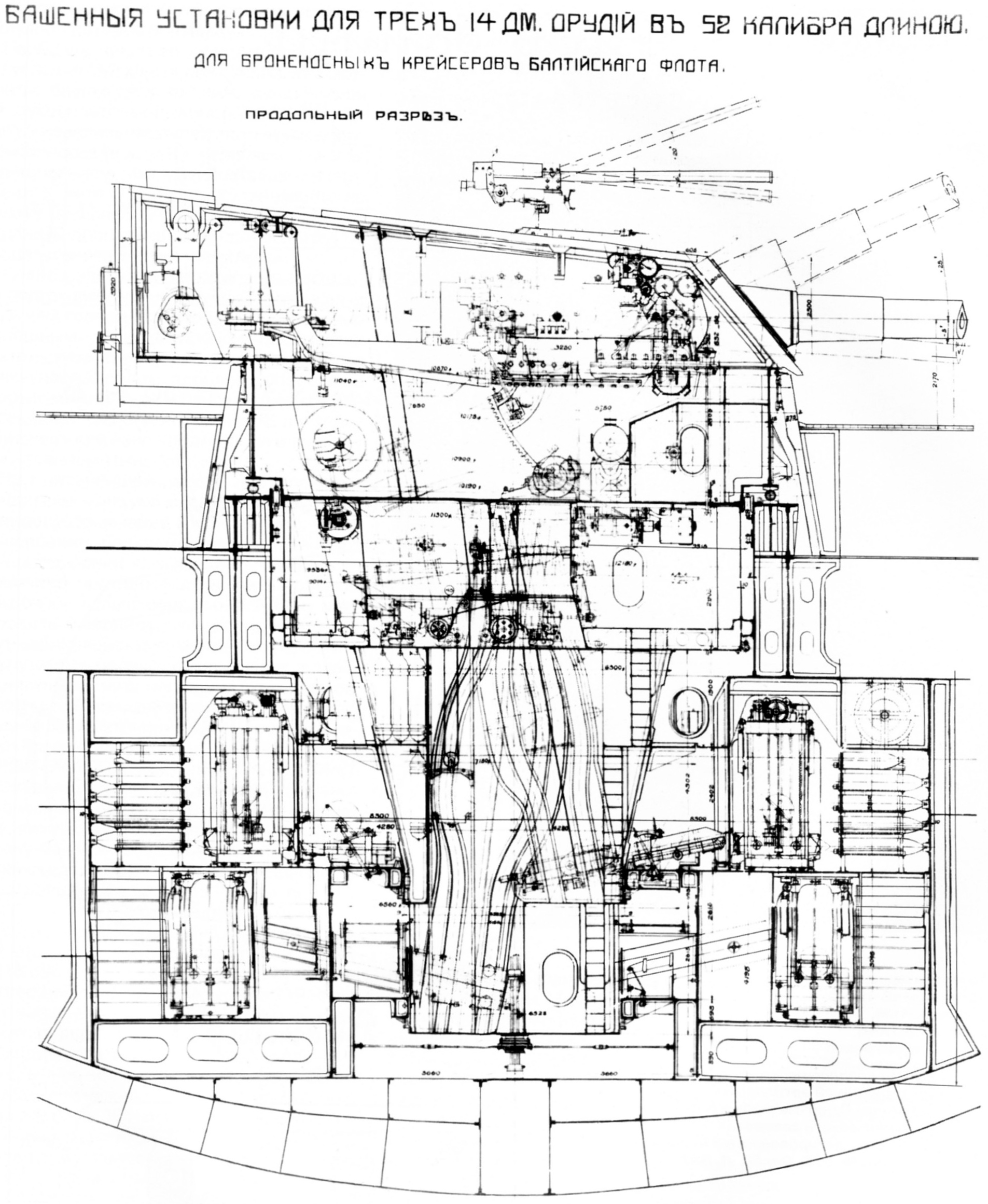
cross section of the 356mm triple-gun turret
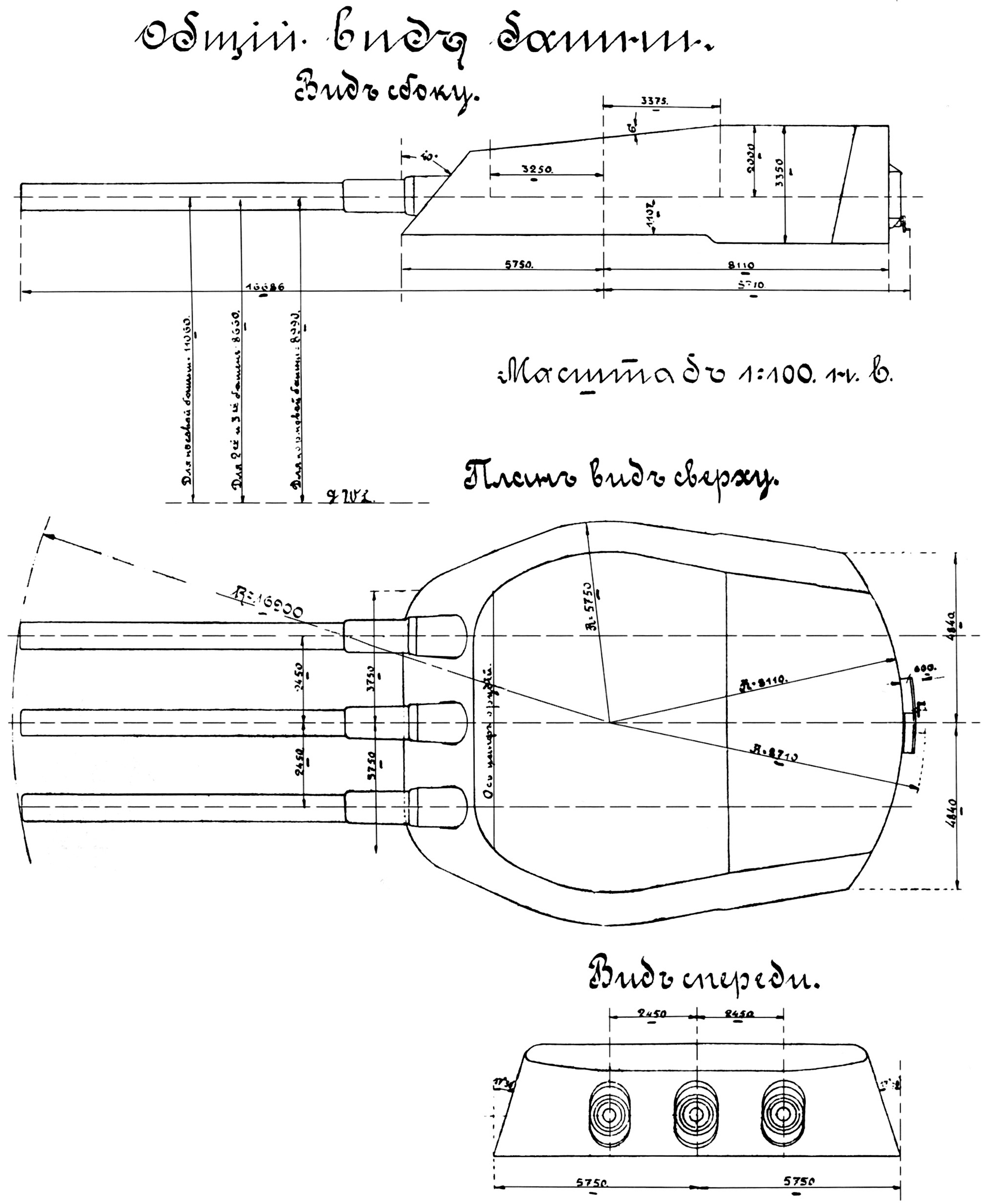
|
|
And now for the ammo:
356mm HE shell, Central Naval Museum, St. Petersburg, Russia
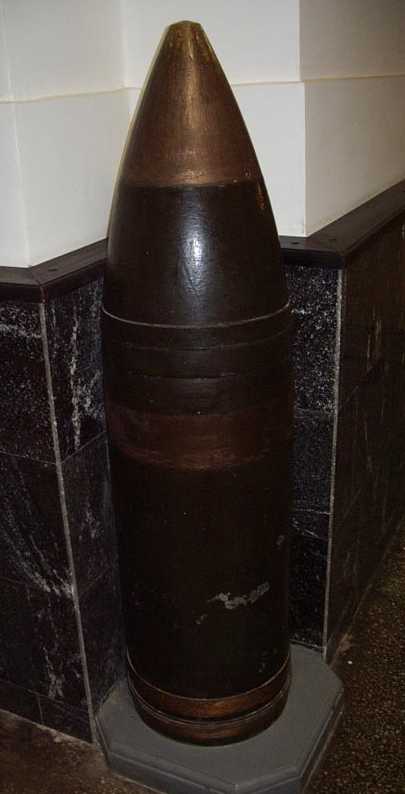
the right picture is the standard AP shell (APCBC?)
the left picture however is a 356mm HE shell… that’s really actually more a SAPBC / Common shell as it has a base fuze and a ballistic cap.

|
|
there’s a surprisingly large smattering of shells for this gun, one from the UK, a couple from 1911, some from 1913, and one from 1928. considering this gun saw more action with the Red Army, and more testing from the Royal Navy upon forced adoption, i’m including all.
despite just being called HE, each HE shell like the museum piece seen above (maybe save for the 1928 shell) seems to be SAP-HE rather than pure base fuzed HE.
there were also 3 different versions of Mod.1913 HE shell with differing bursting charges and shell lengths that all have the same name, which Navweaps arbitrarily identifies as “model 1913, model 1913j, and model 1913a”.
for simplicity, i’m calling these the Pattern 1913 standard, long, and short
APC Mk.Ia:
Weight- 719.4 kg; bursting charge- 27.9 kg; length- unknown, probably around 135 cm; propellant charge- 141.97 kg (MD45 Cordite); muzzle velocity- 753 m/s
Pattern 1911 AP:
Weight- 747.8 kg; bursting charge- 20.38 kg; length- 138.8 cm; propellant charge- 203 kg; muzzle velocity- 731.5 m/s
Pattern 1913 HE (standard):
Weight- 747.8 kg; bursting charge- 75.85 kg; length- 167.32 cm; propellant charge- 203 kg; muzzle velocity- 731.5 m/s
Pattern 1913 HE (long):
Weight- 747.8 kg; bursting charge- 81.9 kg; length- 169.1 cm; propellant charge- 203 kg; muzzle velocity- 731.5 m/s
Pattern 1913 HE (short):
Weight- 747.8 kg; bursting charge- 66.3 kg; length- 158.77 cm; propellant charge- 203 kg; muzzle velocity- 731.5 m/s
Pattern 1928 HE:
Weight- 511.5 kg; bursting charge- 88.2 kg; length- 177.55 cm; propellant charge- 230 kg; muzzle velocity- 980.0 m/s
according to “Morskie Pushki na Geleznoi Dorogie”, the original estimation on muzzle velocity was supposed to be about 823 m/s, compared to the 731 m/s that was showed in practice. This proved the British disappointments with the Pattern 1913 design in that it simply just wasn’t strong enough.
|
|
24x1 130mm/55 Pattern 1913 cannons - the same model as on Imperatritsa Mariya ingame
all 12 per side mounted in casemates.
|
|
8x1 - 75mm/50 pattern 1892 Canet guns in single AA mounts on top each main gun turret
the same model and maybe mount as on Imperatritsa Mariya ingame, and a little farther back towards the middle of the turret than the singles seen on Imperatritsa Mariya ingame
given the time frame, the specific noting that these are AA cannons, and the Borodinos relationship to the Imperatritsa Maria-class (which was originally supposed to have these 14-inch cannons) in their armament, the specific model of AA mount would be likely be the Pattern 1914 AA mount
overhead cross section of main gun turrets, specifically showing where the 75mm Canet guns were placed, showing their traverse at 0° and 90° angles
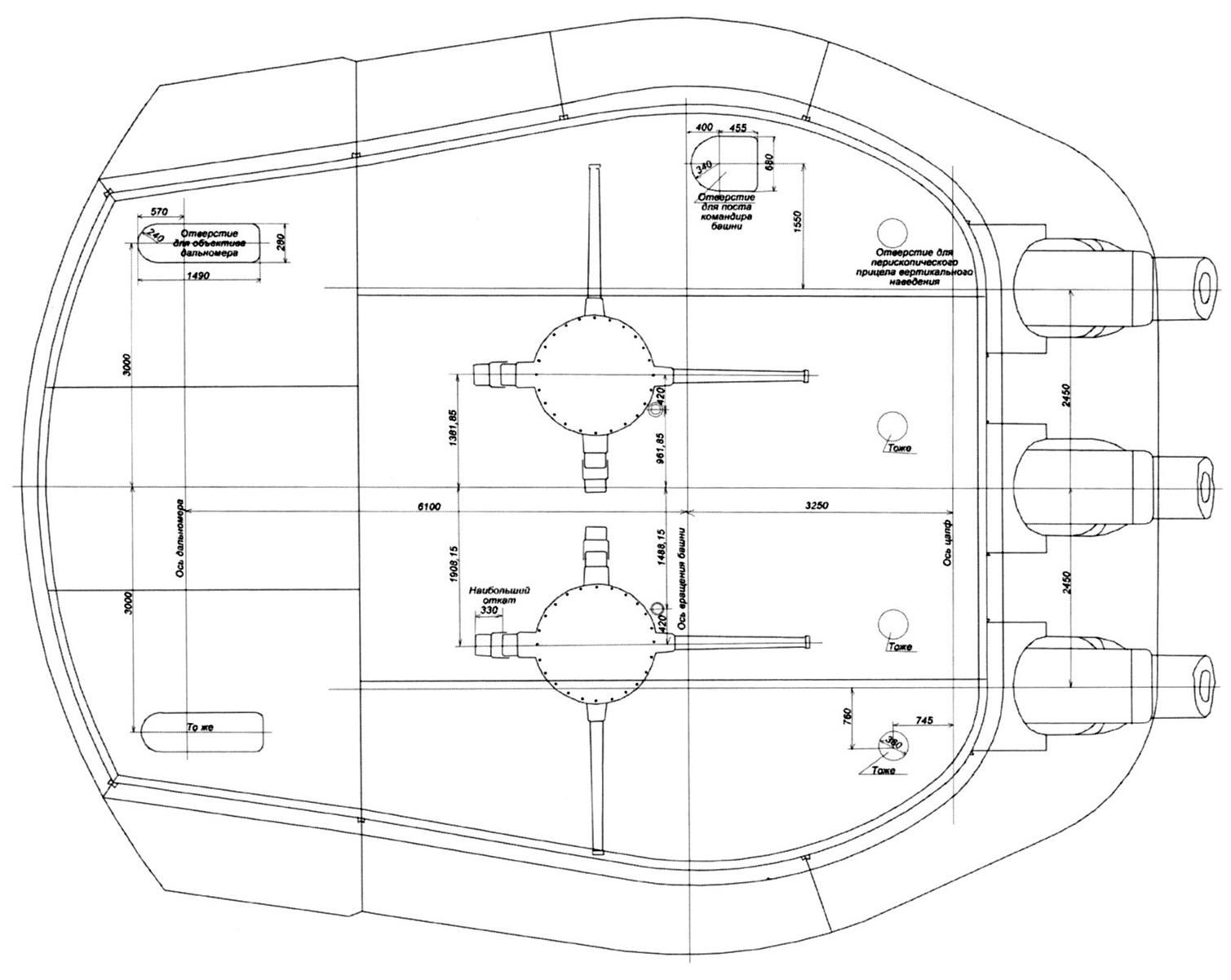
|
|
4x1 - 63.3mm/38 (2.5-inch) Pattern 1916 Obukhov Works AA cannon fitted on single mounts on the upper deck
http://www.navweaps.com/Weapons/WNRussian_25-38_m1916.php
|
|
2x3 - 450mm (17.7 in) underwater torpedo tubes, three on each broadside; with ammo count of 18 torpedoes (6 in the chamber, 2 reloads each).
like all russian/soviet ships (save for Noviki destroyers), with 450mm torpedoes from 1907 to post-WWII, applicable models are Patterns 1907, 1908, 1910, and 1912 torpedoes. and given that Imperatritsa Mariya ingame uses the Pattern 1912 wet-heater torpedo, it’ll be this.
SOURCES:
online:
https://ru.wikipedia.org/wiki/Линейные_крейсера_типа_«Измаил»
https://ru.wikipedia.org/wiki/Измаил_(линкор)
https://ru.wikipedia.org/wiki/Кинбурн_(линкор)
https://ru.wikipedia.org/wiki/Бородино_(линкор)
https://ru.wikipedia.org/wiki/Наварин_(линкор)
http://navsource.narod.ru/photos/01/042/index.html
http://navsource.narod.ru/photos/01/041/index.html
http://navsource.narod.ru/photos/01/043/index.html
http://navsource.narod.ru/photos/01/044/index.html
http://www.navypedia.org/ships/russia/ru_bb_izmail.htm
https://wiki.wargaming.net/ru/Navy:356-мм_орудие_образца_1913_года - massive amount of information
literary:
Conway’s All the Worlds Ships 1906-1921, PDF/DjVu page 314
-
Breyer, Siegfried (1992). Soviet Warship Development. Volume I: 1917–1937. London: Conway Maritime Press. ISBN 0-85177-604-3.
-
McLaughlin, Stephen (2003). Russian & Soviet Battleships. Annapolis, Maryland: Naval Institute Press. ISBN 1-55750-481-4.
-
Silverstone, Paul H. (1984). Directory of the World’s Capital Ships. New York: Hippocrene Books. ISBN 0-88254-979-0.
-
Watts, Anthony (1990). The Imperial Russian Navy. London: Arms and Armour Press. ISBN 0-85368-912-1.
-
Виноградов С. Е. «„Измаил“: сверхдредноут Российской империи» — Морская коллекция, 2001 ( Vinogradov S. Ye. “Izmail: Superdreadnought of the Russian Empire” - Marine collection, 2001)
-
В. Ю. Усов «Линейные крейсеры типа „Измаил“» — Судостроение, 1986, № 7 По материалам ЦГАВМФ ( Usov V. Yu. “Battlecruisers of the” Izmail “type” - Shipbuilding, 1986, No. 7 Based on materials from TsGAVMF)
-
Л. А. Кузнецов «Почему не достроили линейные крейсеры типа „Измаил“» — Сборник Гангут № 1 ( Kuznetsov L. A. “Why the battle cruisers of the” Izmail “type were not completed” - Collection of Gangut No. 1)
-
Тарас А. Корабли Российского императорского флота 1892-1917 гг. — Харвест, 2000. — ISBN 9854338886. ( Taras A. Ships of the Russian Imperial Navy 1892-1917 - Harvest, 2000 .-- ISBN 9854338886 .)
-
Шацилло К. Ф. Последняя военно-морская программа царского правительства // Отечественная история. 1994. No 2. С. 161–165. (Shatsillo K.F. The last naval program of the tsarist government // Fatherland history. 1994. No 2.P. 161–165.)
“Entsiklopedia Otechestvennoi Artillerii” (Encyclopedia of Fatherland (Russian) Artillery) by A.V. Shirokorad
“Morskie Pushki na Geleznoi Dorogie” (Naval Guns on Railroads) by L.I. Amirchanov
(talking about the 356mm/52 Pattern 1913 gun)
